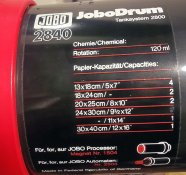Paul Mrn
Member
Hello all,
Before I start, I apologize in advance if some of the words I used lack accuracy, English is not my native language.
I've started processing RA-4 color prints and have not run into major problems so far. I'm processing on a Jobo CPE2, with a Tetenal RA-4 kit.
I've noticed, however, that out of my original 120mL that I'm supposed to pour in the drum, I get back around 115/110mL once the developer time is up (depending on the size of the paper, so far I have never processed anything above 5x8 so nothing very large).
I've had a hard time finding content on that issue, if it is an issue at all. I understand it is "natural" that the paper drinks up a bit of chemical, but does it mean I have to refill every time I process to reach back the 120mL? I can do that obviously but I just felt that it was quite a lot of developer being consumed and so it was not great for the "productivity" of the kit (I mean that it would make me "run out" of developer faster than it is supposed to last.
I hope I have been clear enough, thanks in advance for the help!
Paul
Before I start, I apologize in advance if some of the words I used lack accuracy, English is not my native language.
I've started processing RA-4 color prints and have not run into major problems so far. I'm processing on a Jobo CPE2, with a Tetenal RA-4 kit.
I've noticed, however, that out of my original 120mL that I'm supposed to pour in the drum, I get back around 115/110mL once the developer time is up (depending on the size of the paper, so far I have never processed anything above 5x8 so nothing very large).
I've had a hard time finding content on that issue, if it is an issue at all. I understand it is "natural" that the paper drinks up a bit of chemical, but does it mean I have to refill every time I process to reach back the 120mL? I can do that obviously but I just felt that it was quite a lot of developer being consumed and so it was not great for the "productivity" of the kit (I mean that it would make me "run out" of developer faster than it is supposed to last.
I hope I have been clear enough, thanks in advance for the help!
Paul












